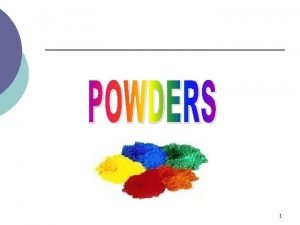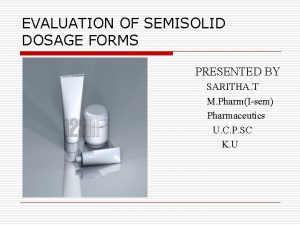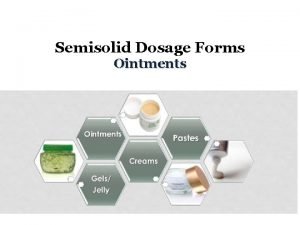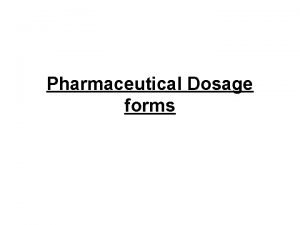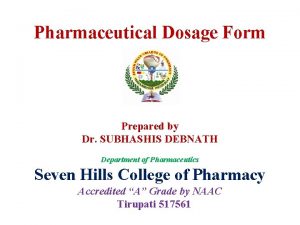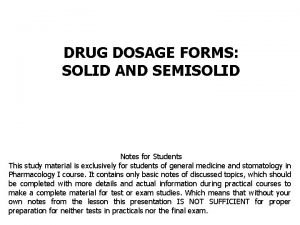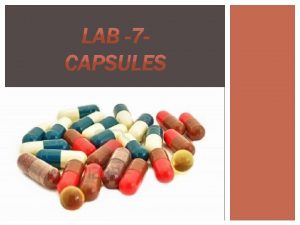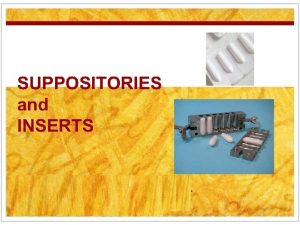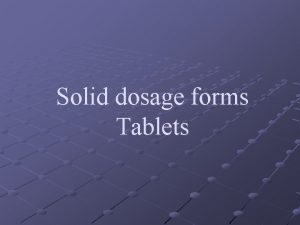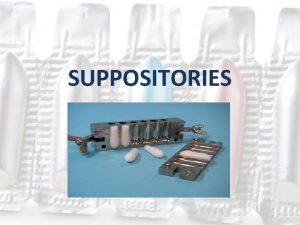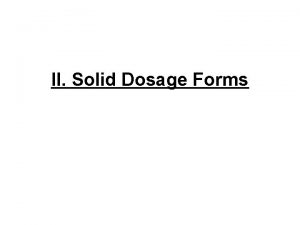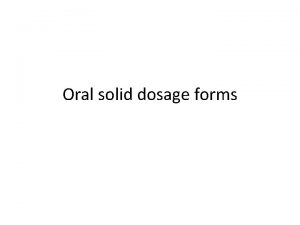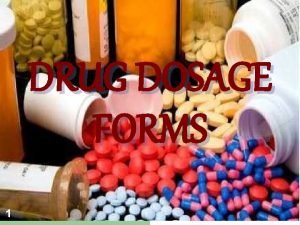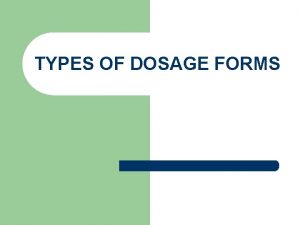POWDERS Part I POWDERS are solid dosage forms











- Slides: 11

POWDERS Part I

POWDERS are solid dosage forms for internal and external application consisting of one or some medicinal substances and having a loose property

ADVANTAGES OF POWDERS n n The simplicity of preparation, convenience of administration and a great bioavailability (comparing with tablets). 2. The universality of the composition. It means that in the form of powders it is possible to combine medicinal substances, which are different by the structure and properties. 3. It is possible to measure powders precisely. 4. The convenience of storage and transportation.

DISADVANTAGES OF POWDERS n n n 1. A poor safety, which is connected with a large specific surface. They lose or absorb water, they are readily oxidized, ets. 2. Inconvenience of administration of aromatic, colouring substances and substances having unpleasant taste. 3. Some medicinal substances in the form of powders can irritate the mucous membrane of the stomach with internal use.

THE MAIN TECHNOLOGICAL PROCEDURES OF POWDER’S PREPARING n n Weighing, powdering and sifting of medicinal substances. Blending of components (for complex powders). Dosing on a mass, packing of doses and quality control of powders. Powder registration for dispensing.

In all variety of formulas of complex powders 2 cases may be distinguished: n n The 1 -st case - when the medications of a complex powder are prescribed in equal or approximately equal amounts; The 2 -nd case - when the medications of a complex powder prescribed in extremely different amounts.

The 1 -st case - when the medications of a complex powder are prescribed in equal or approximately equal amounts In the first case, when medicinal substances are prescribed in equal amounts and their physical and chemical properties are the same, the order of blending has not significant, they are mixed in order of prescribing, as a rule.

The 1 -st case - when the medications of a complex powder are prescribed in equal or approximately equal amounts If the amounts of prescribed substances are the same, but their physical and chemical properties differ, there are following rules of blending: 1. The substance without activity should be powdered first.

The 1 -st case - when the medications of a complex powder are prescribed in equal or approximately equal amounts 2. If there is no substance without activity in the formula, at first the substance having the least percent of rubbing in pores of a mortar is triturated. Frequently the value of powder’s losses is explained by electrization of mortar’s wales and a powder (different charges). Therefore, it is important to foresee the value of losses correctly for solving the problem of ingredients’ trituration in a clean mortar because the losses while triturating a substance in a clean mortar are rather great. 3. At first the coarse-crystalline substances should be powdered, then fine-crystalline ones and, at last, amorphous ones. 4. The heavy substances should be added in the mortar first, then –lighter substances are added. The easily spraying substances added last.

The 2 -nd case - when the medications of a complex powder prescribed in extremely different amounts. When the medicinal substances of a complex powder are prescribed in different amounts, the main rules of blending are: 1. Start powdering in the mortar with medicinal substances without therapeutical activity, and if there is not such a substance in the formula, the preparation should begin from a component prescribed in greater quantity and which is less lost in the mortar’s pores (taking into account the crystalline structure and spraying ability of a substance).

The 2 -nd case - when the medications of a complex powder prescribed in extremely different amounts. 2. After that it is nesessary to start powdering and blending of medicinal substances with a component prescribed in the smallest amount ( in the mortar where the substance without activity previously added). Then add the remaining components gradually, taking into account their amounts. The procedure of blending from the smallest component to the biggest one must be the same. The homogeneity of a powder mixture is reached when components are prescribed in the ratio from 1: 1 (for poisonous and strong-effective substances) to 1: 5 (for substances of the general list). When the ratio is increased more than 1: 5, the homogeneity of a mixture is greatly disturbed.
 Antigentest åre
Antigentest åre Bulk powders and divided powders
Bulk powders and divided powders Semi solid dosage form
Semi solid dosage form Definition of dosage form
Definition of dosage form Dosage form
Dosage form The finely divided solid dosage forms inhaled into nostrils
The finely divided solid dosage forms inhaled into nostrils Semisolid dosage forms classification
Semisolid dosage forms classification Pan polishing capsules
Pan polishing capsules Miscellaneous base for suppositories
Miscellaneous base for suppositories Solid
Solid Semi solid dosage form definition
Semi solid dosage form definition Hand rolling suppositories
Hand rolling suppositories

